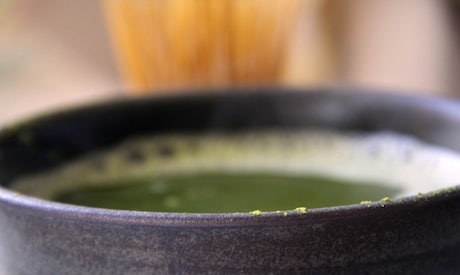
Matcha is a polyphenol-dense green tea used for centuries in Asia. Used at least since the 7th or 8th century in China, and various other parts of Asia soon after, it is believed to have been brought to Japan in the 12th century specifically for the purposes of tea ceremonies by Zen Buddhist Monk Myoan Eisai.
The preparation of matcha during a Japanese tea ceremony is very much about pleasing the guests, both aesthetically and emotionally. It is a pure act of respect, and the entire process is considered to be a gesture of the heart. Often, after the matcha is whisked (with water that should be hot but not boiled), there are sweets served to counteract the bitter taste of the tea. This bitterness is attributed to the high concentration of amino acids. Once prepared, the bowl of matcha tea is then passed to each participant of the ceremony. The tools used to prepare the matcha are placed for all to see in the otherwise simple, spacious Tatami-mat room.
The difference in the nutritional properties between regular green tea and matcha is in the practices that begin about three weeks before harvesting the leaves. The tea leaves (Camellia sinensis) are covered to shield them from sunlight. This causes a slower growth rate and creates darker, bitter leaves with high concentrations of amino acids. When ready, the best leaves are carefully hand-picked and laid out to dry. When harvested this way, the product is known as tencha, which is what true matcha is made from. The price variance in the market (true matcha can be quite expensive as it usually takes about an hour to ground just 30 grams of powder) is usually on account of whether the ground leaves are regular green tea leaves or tencha.
Matcha Tea Health Benefits
By now, it’s no secret that green tea is good for the body. In addition to antioxidants, it provides caffeine usually without the jittery effects of coffee. If a person is sensitive to caffeine, a decaffeinated green tea still has the healthful properties. One of the reasons matcha is more potent than other green teas is because the entire leaf is being consumed as opposed to the traditionally steeping. In addition to the way matcha is harvested, this makes it a powerhouse tea. The polyphenols (including EGCGs) are amazing antioxidants which have been shown in various studies to prevent oxidative damage and degenerative diseases. It has also been shown to reduce glucose, triglycerides, and cholesterol in rats. A few of the main nutrients in matcha are:
- Chlorophyll-aids in detoxification, cleansing, oxygenating blood, building immunity
- Epigallocatechins (EGCG)-prevents skin/oxidative damage from high exposure to radiation (including skin cancer), aids in alcoholic intoxication recovery, improves immunity, boosts metabolism
- Amino Acids (essential and non-essential)-used as building blocks for protein needed for hair growth, repair, recovery, immunity
How to Use Matcha
Matcha lattes are easily made using any milk or milk substitute (almond milk works quite well). For a single serving, put about one teaspoon of matcha into a small pot (slightly more or less is fine depending on personal taste), and then add about 2 ounces of heated water to it. Wait until matcha is well mixed (no clumps), and while keeping it on a slow boil, add desired milk or milk substitute. If sweetener is to be added, it should be at the initial stage when the dry matcha is put into the pot, before the hot water is added.
Matcha can be had as a regular tea with just hot water, in which case just add a small amount of the heated water at a time to ensure there are no clumps. Again, if sweetener is desired, it is best to add it in the beginning.
Other uses for matcha include:
- Smoothies
- Shakes
- Baked goods
- Ice cream
Matcha is a fantastic way to get a boost throughout the day, and can be enjoyed regularly in many ways for good health.
[Editor's Note: Our sponsor Uncle Matt's has a delicious Matcha Lemonade.]
Read More: Healthy Smoothies
References:
http://japanese-tea-ceremony.net/
http://en.wikipedia.org/wiki/Matcha
http://www.ncbi.nlm.nih.gov/pubmed/15113710
http://www.ncbi.nlm.nih.gov/pubmed/15640483
http://www.ncbi.nlm.nih.gov/pubmed/19735169
Elson M. Haas, MD. Staying Healthy with Nutrition. 21st Century Edition, 2006
Image: Jigme Datse




